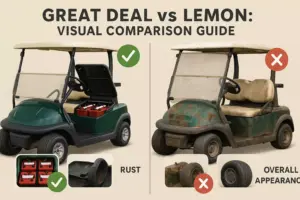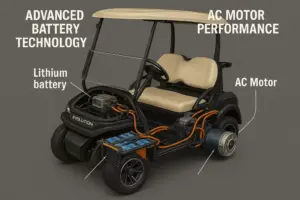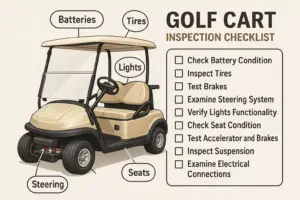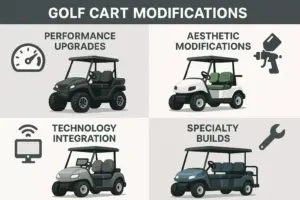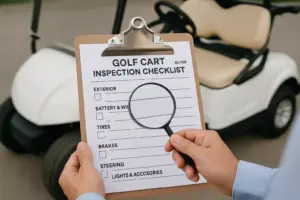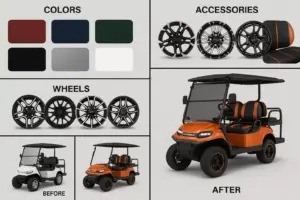The Smart Buyer’s Guide to Used Golf Carts for Sale (2025)
The used golf cart market has exploded beyond the fairways, with sales increasing by over 35% in the past three years as savvy buyers discover these versatile vehicles for neighborhood transportation, beach cruising, and property maintenance. Whether you’re seeking an affordable alternative to a second car or need reliable transportation for your retirement community, finding the right used golf cart requires insider knowledge that most dealerships won’t share.
Key Takeaways

- Budget wisely: Quality used golf carts range from $3,000-$8,000, with electric models typically costing more upfront but offering lower maintenance costs
- Inspect thoroughly: Battery condition, tire wear, and steering components are the most critical areas that determine long-term value
- Know your power source: Electric carts excel for short, frequent trips while gas models handle longer distances and heavier loads
- Verify legality: Street-legal requirements vary by state and municipality, affecting both purchase price and ongoing compliance costs
- Consider total ownership costs: Factor in insurance, maintenance, storage, and potential upgrades when calculating your investment
Understanding the Used Golf Cart Market in 2025
The used golf cart landscape has transformed dramatically, with residential buyers now representing nearly 60% of all purchases. This shift has created a diverse marketplace where traditional golf course trade-ins compete with custom-built carts and commercial fleet vehicles.
Market Trends Shaping 2025 Prices
Several factors are influencing used golf cart values this year:
- Supply chain improvements have stabilized new cart production, slightly cooling used prices
- Lithium battery adoption is creating a two-tier market between older lead-acid and newer lithium-powered carts
- Street-legal modifications are adding significant value to compliant vehicles
- Seasonal demand continues to peak in spring and early summer, affecting pricing by 15-20%
Types of Used Golf Carts: Electric vs. Gas
Electric Golf Carts: The Popular Choice
Electric golf carts dominate the used market for good reason. They offer quiet operation, lower maintenance requirements, and increasing range capabilities with modern battery technology.
Advantages:
- Minimal maintenance (no oil changes, tune-ups, or fuel filters)
- Quiet operation ideal for residential areas
- Lower operating costs (electricity vs. gasoline)
- Instant torque for smooth acceleration
- Environmentally friendly operation
Disadvantages:
- Limited range (typically 25-40 miles per charge)
- Battery replacement costs ($800-$3,000 depending on type)
- Longer “refueling” time (4-8 hours to charge)
- Reduced performance in extreme cold weather
Gas-Powered Golf Carts: The Workhorses
Gas carts excel in applications requiring extended range or heavy-duty performance. They’re particularly popular for commercial use and large property maintenance.
Advantages:
- Extended range (100+ miles per tank)
- Quick refueling (5 minutes vs. hours)
- Better performance with heavy loads
- More power for hill climbing
- Lower upfront costs typically
Disadvantages:
- Regular maintenance requirements (oil, filters, spark plugs)
- Noise and emissions
- Higher operating costs
- More complex mechanical systems
Essential Inspection Checklist for Used Golf Carts

Battery System Evaluation (Electric Carts)
The battery pack represents 30-50% of an electric cart’s value, making this the most critical inspection area.
Lead-Acid Battery Inspection:
- Check manufacturing dates (replace every 4-6 years)
- Test voltage under load with a multimeter
- Inspect for corrosion, cracked cases, or bulging
- Verify water levels in each cell
- Look for sulfation (white crystalline buildup)
Lithium Battery Assessment:
- Verify battery management system functionality
- Check cycle count if available
- Test charging behavior and completion
- Inspect for physical damage or swelling
Motor and Drive System
Electric Motor Checks:
- Listen for unusual noises during operation
- Test acceleration smoothness
- Verify regenerative braking function
- Inspect motor mounting and connections
Gas Engine Evaluation:
- Check oil condition and level
- Listen for irregular idle or knocking sounds
- Test acceleration and power delivery
- Inspect air filter and fuel system
- Verify cooling system operation
Chassis and Suspension Components
A thorough chassis inspection reveals how the cart has been used and maintained:
- Tire condition: Look for even wear patterns and adequate tread depth
- Steering components: Check for play in the steering wheel and worn tie rods
- Suspension: Inspect leaf springs or shock absorbers for wear
- Frame integrity: Look for rust, cracks, or accident damage
- Brake system: Test stopping power and inspect brake cables/pads
Body and Electrical Systems
- Body panels: Check for cracks, fading, or impact damage
- Seats: Inspect upholstery condition and frame integrity
- Lights and signals: Test all electrical components
- Charging system: Verify proper charger operation (electric carts)
- Accessories: Evaluate condition of any added features
Where to Find Quality Used Golf Carts
Authorized Dealers
Pros:
- Professional inspections and reconditioning
- Limited warranties available
- Trade-in options
- Financing assistance
- Parts and service support
Cons:
- Higher prices (typically 20-30% premium)
- Limited negotiation flexibility
- Smaller inventory selection
Golf Course Sales
Many courses regularly update their fleets, creating opportunities for well-maintained carts.
What to expect:
- Higher mileage but consistent maintenance
- Basic configurations without luxury features
- Competitive pricing
- Bulk purchase opportunities
- Known maintenance history
Private Sellers
Advantages:
- Best pricing opportunities
- Detailed ownership history
- Potential for unique customizations
- Direct negotiation with owner
Risks:
- No warranty protection
- Unknown maintenance history
- Potential for undisclosed problems
- Limited recourse for issues
Online Marketplaces
Platforms like Facebook Marketplace, Craigslist, and specialized golf cart sites offer vast selections but require careful evaluation.
Safety tips:
- Always inspect in person before purchasing
- Meet in safe, public locations
- Verify ownership with title/registration
- Bring a knowledgeable friend or mechanic
- Use secure payment methods
Pricing Guide: What to Expect in 2025
🚗 Used Golf Cart Price Calculator
Typical Price Ranges by Category
Budget Range ($2,000 – $4,000):
- Older gas carts (2005-2012)
- High-mileage electric carts with lead-acid batteries
- Basic configurations without upgrades
- Fair to good condition
Mid-Range ($4,000 – $7,000):
- Recent electric carts (2015-2020) with good batteries
- Well-maintained gas carts with low hours
- Some accessories and upgrades
- Good to excellent condition
Premium Range ($7,000 – $12,000+):
- Nearly new electric carts with lithium batteries
- Street-legal configurations
- Extensive customizations and upgrades
- Excellent condition with warranties
Financing and Payment Options
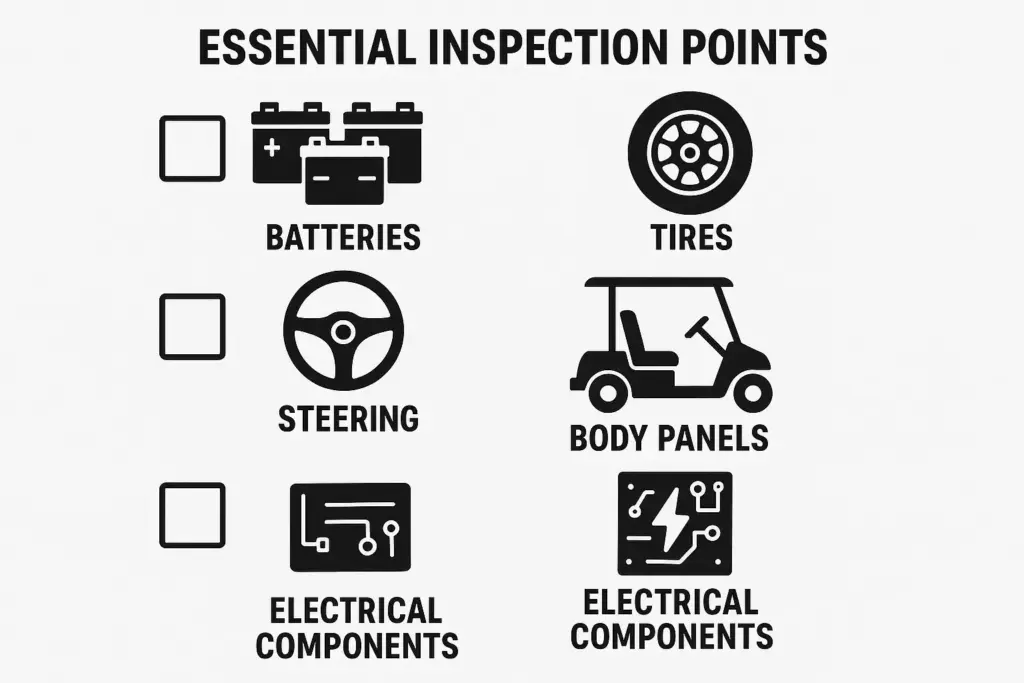
Traditional Financing
Many dealerships offer financing through partnerships with banks and credit unions. Interest rates typically range from 6-15% depending on credit score and loan term.
Typical terms:
- 36-60 month loan periods
- Down payments of 10-20%
- Credit score requirements of 650+
Alternative Financing
- Personal loans: Often faster approval but higher rates
- Home equity loans: Lower rates but require home ownership
- Credit cards: Convenient for smaller purchases but high interest
- Rent-to-own programs: Higher total cost but lower barriers to entry
Cash Purchase Benefits
Paying cash provides significant advantages:
- Negotiation leverage for better pricing
- No interest charges or monthly payments
- Immediate ownership without lien holders
- Simplified paperwork and faster transactions
Legal Considerations and Registration
Street Legal Requirements
Converting a golf cart for street use involves specific modifications and varies by location:
Common requirements:
- Headlights, taillights, and turn signals
- Mirrors and windshield
- Seat belts and DOT-approved tires
- Horn and speedometer
- Minimum speed capability (usually 20-25 mph)
Registration and Insurance
Registration requirements vary by state:
- Some states treat golf carts as low-speed vehicles (LSVs)
- Others require standard vehicle registration
- Age restrictions may apply for operators
- Specific licensing requirements in some areas
Insurance considerations:
- Homeowner’s insurance may provide limited coverage
- Specialized golf cart insurance is available
- Liability coverage is essential for street use
- Comprehensive coverage protects against theft and damage
Maintenance and Ownership Costs
Electric Cart Maintenance
Annual maintenance costs: $200-$400
Regular maintenance includes:
- Battery maintenance and testing
- Tire rotation and replacement
- Brake adjustments
- Electrical system checks
- Cleaning and lubrication
Major expenses:
- Battery replacement: $800-$3,000 (every 4-8 years)
- Motor replacement: $500-$1,200 (rare)
- Controller replacement: $300-$800
Gas Cart Maintenance
Annual maintenance costs: $300-$600
Regular maintenance includes:
- Oil changes every 125 hours or annually
- Air filter replacement
- Spark plug replacement
- Fuel system maintenance
- Belt and cable adjustments
Major expenses:
- Engine rebuild: $800-$1,500
- Transmission service: $200-$500
- Carburetor rebuild: $150-$300
Red Flags to Avoid When Buying Used

Seller Red Flags
- Reluctance to allow thorough inspection
- No maintenance records or documentation
- Pressure for immediate purchase
- Unwillingness to demonstrate operation
- Vague answers about cart history
Mechanical Red Flags
- Excessive rust or corrosion
- Unusual noises during operation
- Erratic performance or power loss
- Damaged or modified wiring
- Mismatched or worn components
Financial Red Flags
- Prices significantly below market value
- Cash-only transactions without proper documentation
- Unclear title or ownership status
- Hidden fees or surprise charges
- Pressure to finance through specific lenders
Negotiation Strategies for Best Deals
Research-Based Negotiation
Armed with market knowledge, approach negotiations strategically:
- Know comparable prices from multiple sources
- Identify specific issues that justify price reductions
- Understand seasonal pricing patterns
- Factor in repair costs for needed maintenance
Timing Your Purchase
Best times to buy:
- Late fall/winter: Reduced demand lowers prices
- End of model years: Dealers clear inventory
- Economic downturns: Increased supply from financial pressure
- Weekdays: Less competition from other buyers
Negotiation Tactics
- Start with a reasonable but low offer based on research
- Point out specific defects or needed repairs
- Bundle accessories or services into the deal
- Be prepared to walk away if terms aren’t acceptable
- Consider total cost including taxes, fees, and immediate needs
Smart Buying Tips for Different Use Cases
Retirement Community Transportation
Priorities:
- Comfort features (padded seats, smooth ride)
- Easy entry/exit design
- Reliable electric operation
- Weather protection options
- Storage compartments
Recommended features:
- Four-passenger seating
- Slow-speed modes for safety
- LED lighting packages
- Rear-facing seats for social interaction
Beach and Resort Use
Priorities:
- Corrosion resistance
- Sand and water protection
- Durable upholstery
- Easy cleaning capability
- Reliable performance in heat
Recommended features:
- Aluminum frame construction
- Marine-grade wiring
- Waterproof seat covers
- Cooler and storage options
- All-terrain tires
Property Maintenance and Work
Priorities:
- Heavy-duty construction
- Cargo capacity
- Extended range
- Reliable performance
- Service accessibility
Recommended features:
- Gas engine for extended use
- Utility bed or cargo box
- Towing capacity
- Tool storage options
- Rugged tires
Recreational and Family Use
Priorities:
- Safety features
- Entertainment options
- Comfortable seating
- Style and appearance
- Versatile use capability
Recommended features:
- Seat belts and safety equipment
- Bluetooth audio systems
- Custom paint and accessories
- Lift kits for ground clearance
- LED light packages
Future-Proofing Your Purchase
Technology Considerations
The golf cart industry is evolving rapidly with new technologies:
- Lithium battery adoption is accelerating
- Smart connectivity features are becoming standard
- Solar charging options are gaining popularity
- Advanced safety systems are being integrated
Resale Value Protection
Maximize future resale value by:
- Choosing popular brands with strong dealer networks
- Maintaining detailed service records
- Avoiding excessive customization that limits appeal
- Protecting against weather damage
- Keeping original components when upgrading
Upgrade Potential
Consider carts with good upgrade potential:
- Standard battery configurations for easy upgrades
- Accessible wiring for adding accessories
- Strong frame construction for lift kits
- Popular models with abundant aftermarket support
Conclusion
Purchasing a used golf cart in 2025 requires balancing budget constraints with quality expectations while navigating a complex marketplace. The key to success lies in thorough preparation, careful inspection, and understanding the total cost of ownership beyond the initial purchase price.
Smart buyers should prioritize:
- Comprehensive inspections focusing on batteries, motors, and chassis components
- Market research to understand fair pricing for specific models and conditions
- Total cost analysis including maintenance, insurance, and potential upgrades
- Legal compliance with local regulations for intended use
The used golf cart market offers excellent value for buyers who approach the purchase systematically. Whether seeking basic transportation or a fully-equipped recreational vehicle, the right cart awaits those who invest time in research and inspection.
Take action today by defining your specific needs, setting a realistic budget, and beginning your search with the knowledge gained from this guide. Remember that the best deals often require patience, but the perfect cart for your lifestyle and budget is out there waiting to be discovered.

